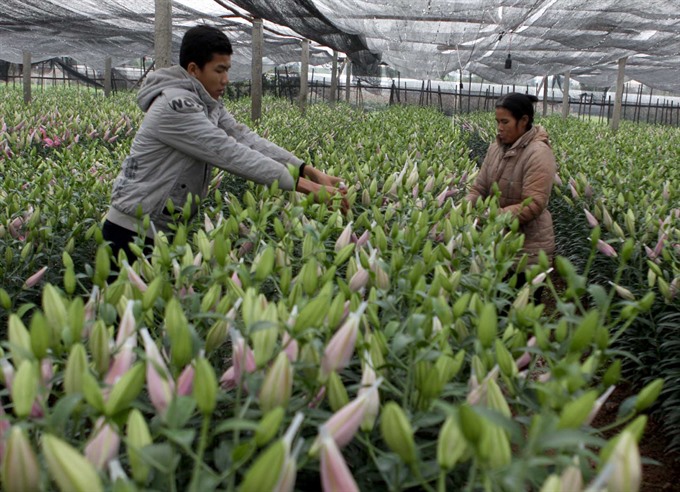 Society
Society

More than 100 ha of farming land in Hạ Mỗ Commune, Hà Nội’s Đan Phượng District have been repurposed to grow lilies during winter instead of conventional crops like corn or beans.
 |
| Farmers tend to lilies in Tây Tựu Village, Nam Từ Liêm District. Tây Tựu farmers expanded flower farming in neigbouring areas. — VNA/VNS Photo Vũ Sinh |
HÀ NỘI — More than 100 ha of farming land in Hạ Mỗ Commune, Hà Nội’s Đan Phượng District have been repurposed to grow lilies during winter instead of conventional crops like corn or beans.
For the last few years, the shift has helped flower farmers gain profits of up to VNĐ2 billion (US$90,000) per hectare, in part because each crop lasts from 70 and 90 days.
Farmers, especially those from the Tây Tựu flower village in Bắc Từ Liêm District, flocked to Hạ Mỗ Commune to rent land and grow lilies.
The Tây Tựu village is now considered the biggest flower granary in Hà Nội, providing a variety of flowers such as daisies, roses, purple heart-bells, and colourful carnations. However, urbanisation has resulted in narrowed farming land, making local flower growers seek other areas for growing flowers.
Nguyễn Văn Cúc, a gardener from Tây Tựu village said that he rented more than 3 mẫu (Vietnamese acre, equivalent to 3,600 sq.m) in Hạ Mỗ Commune in neighbouring Đan Phượng District to grow lilies.
He said that he paid land rental of VNĐ2 million ($90) for each sào (equivalent to 360 sq.m) yearly.
He poured about VNĐ100 million for every sào of lilies including labour cost and fertiliser.
“The investment is quite high but each sào of lilies could generate profit of about VNĐ200 million ($9,000) as long as the weather and market are stable,” he said.
Cúc said that on average, each household there usually grew three or four mẫu of lilies and some had flower farms with areas of 15-20 ha.
He said that local farmers did not worry much about farming technique but rather focus on output for their flowers.
Deputy head of Fruit and Vegetable Research Institute, Đặng Văn Đông, said that since 2012, the institute had aimed to promote lily farming in Hạ Mỗ Commune.
The institute’s staff helped transfer technique and instructed local farmers to grow lilies with breeding imported from the Netherlands, he said.
The cool weather in the north of Việt Nam in winter was a big advantage for lily growing, he said, adding that the quality of lilies grown in Tây Tựu and Hạ Mỗ now was competitive with those grown in other specialised flower-growing zones like Mộc Châu in the mountainous northern Sơn La Province or Đà Lạt in Central Highland.
“Some types of lilies grown in Hà Nội’s suburban district are more beautiful than those imported from Europe or China,” he said.
However, the lilies were sold mostly in domestic market, and preferred during Tết (lunar new year) and festivals.
With current growing area, farmers could get profits but if the area was expanded, price of lily would be likely dropped, posing market risks for farmers, Đông said.
“In the long-term, we must engage competent enterprises that will produce and export flowers,” he said. — VNS




